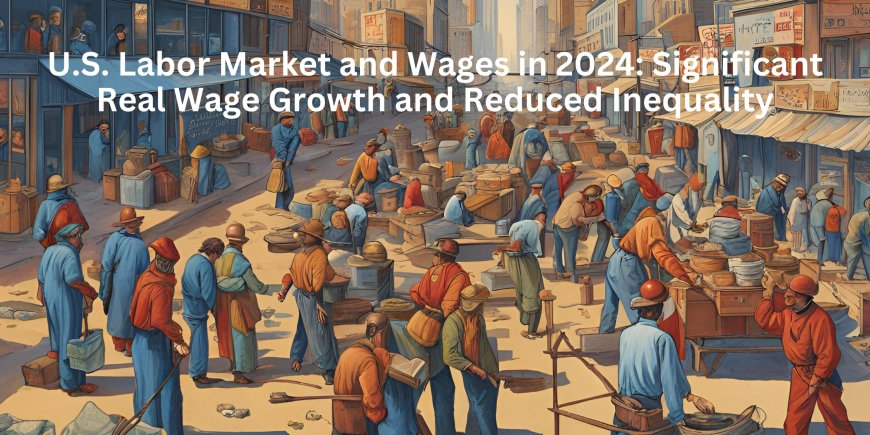U.S. Labor Market and Wages in 2024: Significant Real Wage Growth and Reduced Inequality
Explore the U.S. labor market's resilience with a 26% rise in median hourly wages since the pandemic, focusing on pronounced wage growth for lower-income workers and a historic reduction in wage inequality.

U.S. Labor Market and Wage Growth in 2024: A Deep Dive
Despite inflationary pressures, the U.S. labor market has shown remarkable resilience, with real wages experiencing substantial growth. From the beginning of the pandemic to the end of 2023, the median worker's hourly wages rose by more than 26%. This wage growth has been particularly pronounced for lower-income workers, contributing to a reduction in wage inequality not seen since the 1940s. This article provides an in-depth analysis of these trends, exploring their causes, implications, and future outlook.
Overview of Wage Growth
The rise in real wages, particularly for lower-income workers, marks a significant shift in the U.S. labor market dynamics. Several factors have contributed to this trend:
-
Labor Market Tightness: The labor market has experienced a high demand for workers, leading to increased competition among employers. This has driven up wages across various sectors, particularly in lower-paying industries such as retail and hospitality (The Atlantic).
-
Government Policies: Minimum wage increases at both state and federal levels have played a crucial role in boosting wages for lower-income workers. Additionally, fiscal policies aimed at supporting households during the pandemic have provided financial stability, allowing workers to demand higher wages (The Atlantic).
-
Unionization and Collective Bargaining: There has been a resurgence in unionization efforts and collective bargaining, particularly in sectors traditionally characterized by lower wages. This movement has helped secure better pay and working conditions for many workers (BEA).
Inflation and Real Wage Growth
While inflation has been a concern, real wages, which are adjusted for inflation, have still seen significant growth. The interplay between wage growth and inflation can be complex:
-
Moderate Inflation: Although inflation has risen, it has been relatively moderate compared to historical highs. This has allowed real wages to grow as nominal wages have increased at a faster rate than inflation (The Atlantic).
-
Productivity Gains: Advances in technology and productivity have enabled businesses to absorb higher wage costs without substantially increasing prices. This has helped maintain the purchasing power of workers (The Atlantic)(BEA).
-
Consumer Demand: Strong consumer demand, driven by higher disposable incomes and government stimulus, has allowed businesses to pass on some cost increases to consumers without adversely affecting demand. This dynamic has supported sustained wage growth.
Wage Growth Across Different Sectors
Wage growth has not been uniform across all sectors. Some industries have experienced more significant increases than others:
-
Retail and Hospitality: These sectors have seen some of the highest wage growth rates. The labor shortage in these industries, exacerbated by the pandemic, has forced employers to offer higher wages to attract and retain workers(BEA).
-
Healthcare: The healthcare sector has also experienced substantial wage growth, driven by high demand for medical professionals and support staff. The pandemic highlighted the importance of healthcare workers, leading to increased compensation and better working conditions (The Atlantic).
-
Technology: The technology sector, characterized by high demand for skilled workers, has continued to see robust wage growth. The competition for talent in areas such as software development, cybersecurity, and data analysis has driven up wages significantly (BEA).
Impact on Wage Inequality
One of the most notable outcomes of recent wage trends has been the reduction in wage inequality:
-
Wage Compression: The significant wage increases for lower-income workers have led to a compression in wage differentials. This has narrowed the gap between the highest and lowest earners, contributing to a more equitable distribution of income (BEA).
-
Minimum Wage Policies: The implementation of higher minimum wages has lifted the earnings of the lowest-paid workers, reducing overall wage inequality. States and municipalities that have enacted substantial minimum wage increases have seen the most pronounced effects (The Atlantic).
-
Union Influence: The resurgence of unions and collective bargaining has also played a critical role in reducing wage inequality. Unions have been successful in negotiating higher wages and better benefits for their members, particularly in low-wage industries (The Atlantic) (BEA).
Regional Variations in Wage Growth
Wage growth has also varied significantly across different regions of the United States:
-
Urban vs. Rural: Urban areas have generally seen higher wage growth compared to rural areas. The concentration of high-paying industries such as technology and finance in urban centers has driven this trend. However, some rural areas with booming industries, such as energy or manufacturing, have also experienced significant wage increases (The Atlantic).
-
Regional Policies: States with proactive labor policies, including higher minimum wages and strong labor protections, have seen more substantial wage growth. For example, states like California, New York, and Washington have implemented policies that have significantly boosted wages for lower-income workers (BEA).
-
Economic Activity: Regions with robust economic activity and low unemployment rates have experienced higher wage growth. For instance, states in the South and West, which have seen significant economic expansion, have reported notable increases in wages across various sectors (The Atlantic).
Future Outlook for the U.S. Labor Market and Wages
The future of wage growth and the labor market will depend on several key factors:
-
Economic Conditions: The overall economic conditions, including GDP growth, employment rates, and inflation, will continue to influence wage trends. A strong economy with sustained growth is likely to support ongoing wage increases.
-
Policy Decisions: Government policies, particularly those related to labor markets and wages, will play a crucial role. Continued support for minimum wage increases, labor protections, and worker rights can sustain the positive trends in wage growth and equality (The Atlantic).
-
Technological Advancements: Advances in technology and automation could impact the labor market dynamics. While technology can drive productivity and wage growth, it may also lead to job displacement in certain sectors. Balancing technological innovation with job creation will be essential for maintaining healthy wage growth.
-
Global Economic Factors: Global economic trends, including trade policies, international labor markets, and supply chain dynamics, will also affect the U.S. labor market. The interconnectedness of the global economy means that international developments can have significant domestic implications (BEA).
Policy Recommendations
To sustain and build upon the recent gains in wage growth and reduction in inequality, policymakers should consider several strategic actions:
-
Enhancing Education and Training: Investing in education and workforce training programs can help workers acquire the skills needed for high-demand jobs. This will not only boost individual earnings but also contribute to overall economic growth.
-
Supporting Labor Unions: Encouraging unionization and collective bargaining can help ensure that workers receive fair wages and benefits. Policies that protect workers' rights to organize and negotiate collectively are essential for reducing wage inequality.
-
Addressing Cost of Living: Increases in wages should be complemented by efforts to manage the cost of living, particularly in housing, healthcare, and education. Policies aimed at reducing these costs can help preserve the purchasing power of workers.
-
Promoting Inclusive Growth: Ensuring that economic growth benefits all segments of society is crucial. Targeted support for disadvantaged communities and regions can help bridge gaps and promote more equitable economic outcomes.
-
Balancing Technology and Employment: Policymakers should focus on strategies that harness the benefits of technological advancements while mitigating potential job losses. This includes supporting innovation and entrepreneurship, as well as providing safety nets for displaced workers.
Conclusion
The U.S. labor market has demonstrated remarkable resilience, with real wages rising significantly despite inflationary pressures. The substantial wage growth, particularly for lower-income workers, has led to a reduction in wage inequality not seen since the 1940s. This positive trend reflects a combination of strong labor demand, supportive government policies, and proactive labor movements.
While challenges remain, including the potential impacts of technology and global economic factors, the future outlook for the U.S. labor market and wages is optimistic. By continuing to invest in education, supporting labor unions, addressing the cost of living, promoting inclusive growth, and balancing technology with employment, policymakers can ensure that the gains in wage growth and equality are sustained and built upon.
The trends observed in the U.S. labor market offer valuable lessons for other economies grappling with similar challenges. As the world continues to navigate the complexities of the post-pandemic era, the experiences of the U.S. can provide insights into effective strategies for fostering equitable and sustainable economic growth.

 LD Web Desk
LD Web Desk 